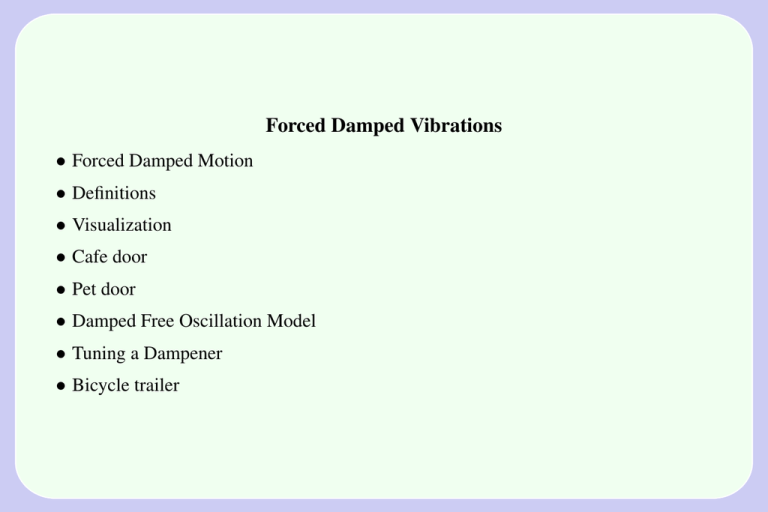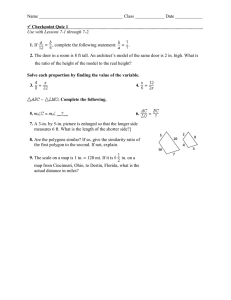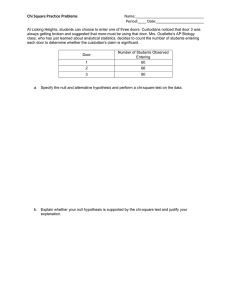Forced Damped Vibrations •
advertisement

Forced Damped Vibrations • Forced Damped Motion • Definitions • Visualization • Cafe door • Pet door • Damped Free Oscillation Model • Tuning a Dampener • Bicycle trailer Forced Damped Motion Real systems do not exhibit idealized harmonic motion, because damping occurs. A watch balance wheel submerged in oil is a key example: frictional forces due to the viscosity of the oil will cause the wheel to stop after a short time. The same wheel submerged in air will appear to display harmonic motion, but indeed there is friction present, however small, which slows the motion. Consider a spring–mass system consisting of a mass m and a spring with Hooke’s constant k, with an added dashpot or dampener, depicted in Figure 1 as a piston inside a cylinder attached to the mass. A useful physical model, for purposes of intuition, is a screen door with door–closer: the closer has a spring and an adjustable piston–cylinder style dampener. k m c Figure 1. A spring-mass system with dampener Model Derivation The dampener is assumed to operate in the viscous domain, which means that the force due to the dampener device is proportional to the speed that the mass is moving: F = cx0 (t). The number c ≥ 0 is called the damping constant. Three forces act: (1) Newton’s second law F1 = mx00 (t), (2) viscous damping F2 = cx0 (t) and (3) the spring restoring force F3 = kx(t). The sum of the forces F1 + F2 + F3 acting on the system must equal the external force f (t), which gives the equation for a damped spring–mass system (1) mx00(t) + cx0(t) + kx(t) = f (t). Definitions The motion is called damped if c > 0 and undamped if c = 0. If there is no external force, f (t) = 0, then the motion is called free or unforced and otherwise it is called forced. Visualization A useful visualization for a forced system is a vertical laboratory spring–mass system with dampener placed inside a box, which is transported down a washboard road inside an auto trunk. The function f (t) is the vertical oscillation of the auto trunk. The function x(t) is the motion of the mass in response to the washboard road. See Figure ??. k x=0 x>0 m c Figure 2. A spring-mass system with dampener in a box transported in an auto trunk along a washboard road. Cafe door Restaurant waiters and waitresses are familiar with the cafe door, which partially blocks the view of onlookers, but allows rapid, collision-free trips to the kitchen – see Figure 3. The door is equipped with a spring which tries to restore the door to the equilibrium position x = 0, which is the plane of the door frame. There is a dampener attached, to keep the number of oscillations low. Figure 3. A cafe door on three hinges with dampener in the lower hinge. The equilibrium position is the plane of the door frame. Model Derivation The top view of the door, Figure 4, shows how the angle x(t) from equilibrium x = 0 is measured from different door positions. x<0 x=0 x>0 Figure 4. Top view of a cafe door, showing the three possible door positions. The figure implies that, for modeling purposes, the cafe door can be reduced to a torsional pendulum with viscous damping. This results in the cafe door equation (2) Ix00(t) + cx0(t) + κx(t) = 0. The removal of the spring (κ = 0) causes the solution x(t) to be monotonic, which is a reasonable fit to a springless cafe door. Pet door Designed for dogs and cats, the small door in Figure 5 allows animals to enter and exit the house freely. A pet door might have a weather seal and a security lock. Figure 5. A pet door. The equilibrium position is the plane of the door frame. The pet door swings freely from hinges along the top edge. One hinge is spring–loaded with dampener. Like the cafe door, the spring restores the door to the equilibrium position while the dampener acts to eventually stop the oscillations. However, there is one fundamental difference: if the spring–dampener system is removed, then the door continues to oscillate! The cafe door model will not describe the pet door. Model Derivation For modeling purposes, the door can be compressed to a linearized swinging rod of length L (the door height). The torque I = mL2/3 of the door assembly becomes important, as well as the linear restoring force kx of the spring and the viscous damping force cx0 of the dampener. All considered, a suitable model is the pet door equation (3) I x00(t) + cx0(t) + k + mgL 2 x(t) = 0. Derivation of (3) is by equating to zero the algebraic sum of the forces. Removing the dampener and spring (c = k = 0) gives a harmonic oscillator x00 (t) + ω 2 x(t) = 0 with ω 2 = 0.5mgL/I , which establishes sanity for the modeling effort. Equation (3) is formally the cafe door equation with an added linearization term 0.5mgLx(t) obtained from 0.5mgL sin x(t). Damped Free Oscillation Model All equations can be reduced, for suitable definitions of constants p and q , to the simplified second order differential equation (4) x00(t) + p x0(t) + q x(t) = 0. Tuning a Dampener • The pet door and the cafe door have dampeners with an adjustment screw. The screw changes the damping coefficient c which in turn changes the size of coefficient p in (4). More damping c means p is larger. • There is a critical damping effect for a certain screw setting: if the damping is decreased more, then the door oscillates, whereas if the damping is increased, then the door has a monotone non-oscillatory behavior. The monotonic behavior can result in the door opening in one direction followed by slowly settling to exactly the door jamb position. If p is too large, then it could take 10 minutes for the door to close! • The critical case corresponds to the least p > 0 (the smallest damping constant c > 0) required to close the door with this kind of monotonic behavior. The same can be said about decreasing the damping: the more p is decreased, the more the door oscillations approach those of no dampener at all, which is a pure harmonic oscillation. As viewed from the characteristic equation r 2 + pr + q = 0, the change is due to a change in character of the roots from real to complex. The physical response and the three cases in Euler’s constant–coefficient recipe lead to the following terminology. Classification Overdamped Critically damped Defining properties Distinct real roots r1 6= r2 Positive discriminant x = c1er1t + c2er2t = exponential × monotonic function Double real root r1 = r2 Zero discriminant Underdamped x = c1er1t + c2 t er1t = exponential × monotonic function Complex conjugate roots α ± i β Negative discriminant x = eαt(c1 cos βt + c2 sin βt) = exponential × harmonic oscillation Bicycle trailer An auto tows a one–wheel trailer over a washboard road. Shown in Figure 6 is the trailer strut, which has a single coil spring and two dampeners. The mass m includes the trailer and the bicycles. k c c Figure 6. A trailer strut with dampeners on a washboard road Road Surface Model Suppose a washboard dirt road has about 2 full oscillations (2 bumps and 2 valleys) every 3 meters and a full oscillation has amplitude 6 centimeters. Let s denote the horizontal distance along the road and let ω be the number of full oscillations of the roadway per unit length. The oscillation period is 2π/ω , therefore 2π/ω = 3/2 or ω = 4π/3. A model for the road surface is y= 5 100 cos ωs. Model Derivation Let x(t) denote the vertical elongation of the spring, measured from equilibrium. Newton’s second law gives a force F1 = mx00 (t) and the viscous damping force is F2 = 2cx0 (t). The trailer elongates the spring by x − y , therefore the Hooke’s force is F3 = k(x − y). The sum of the forces F1 + F2 + F3 must be zero, which implies mx00 (t) + 2cx0 (t) + k(x(t) − y(t)) = 0. Write s = vt where v is the speedometer reading of the car in meters per second. The expanded differential equation is the forced damped spring-mass system equation mx00 (t) + 2cx0 (t) + kx(t) = k 20 cos(4πvt/3). The solution x(t) of this model, with x(0) and x0 (0) given, describes the vertical excursion of the trailer bed from the roadway. The observed oscillations of the trailer are modeled by the steady-state solution xss (t) = A cos(4πvt/3) + B sin(4πvt/3), where A, B √are constants determined by the method of undetermined coefficients. From the physical data, the amplitude A2 + B 2 of this oscillation might be 6cm or larger.





